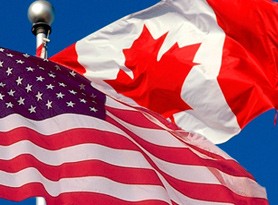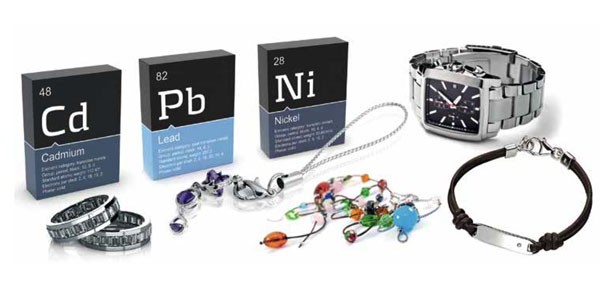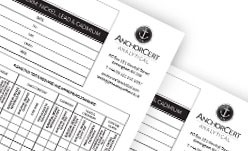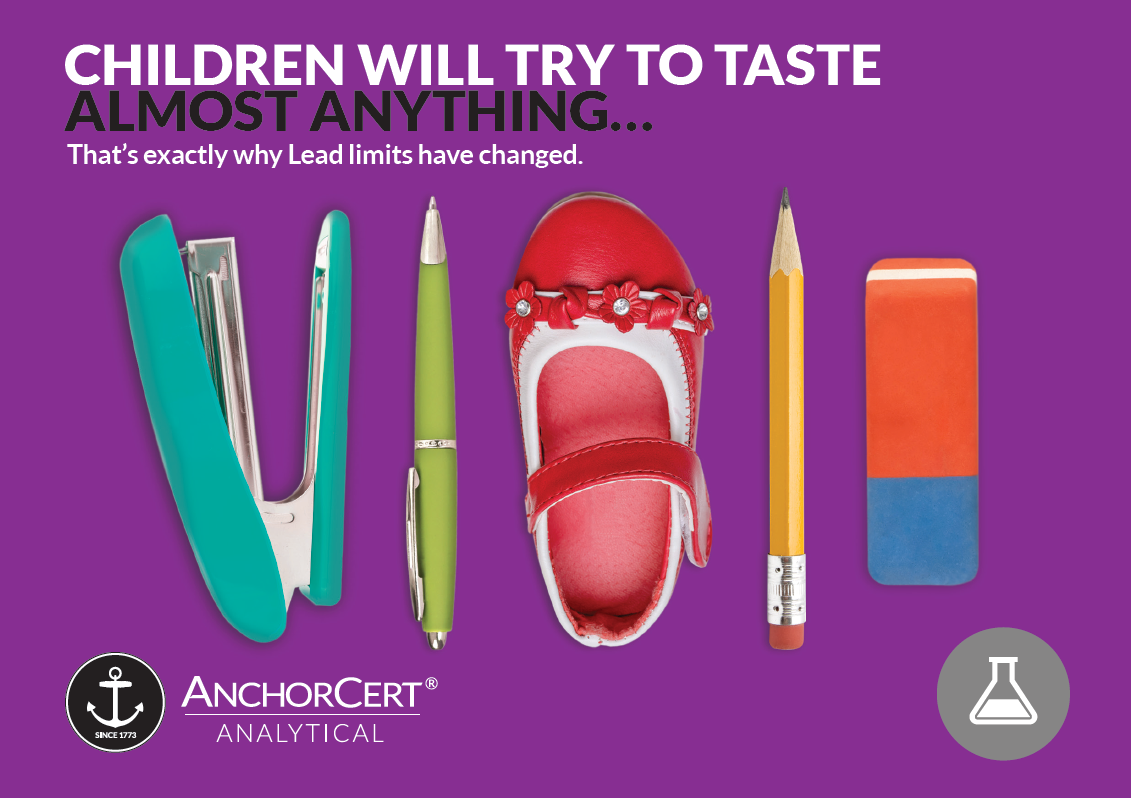|
Lead is a metal which is toxic at very low levels of exposure. It accumulates in the body, so that regular exposure to even very low quantities may result in harmful levels which can badly damage intellectual and behavioural development of infants and young children. Children are particularly susceptible while their central nervous system is still developing and their tendency to “mouth” or suck things makes them particularly vulnerable. Lead also has a variety of adverse health effects on adults, and some are choosing to analyse adult jewellery for lead safety limits too.
A level of 10 micrograms of lead per decilitre of blood (10 μg/dL) is generally recognized as a threshold level of concern with respect to lead poisoning. Children who wear metal jewellery containing accessible lead which can leach out can ingest the lead by handling jewellery and putting their fingers in their mouths, or by putting jewellery directly in their mouths, or by ingesting either parts or whole pieces of the jewellery. This is behaviour that may occur regularly over time (eg, every day that a child has access to an item) and so results in chronic exposure.
Ingestion that occurs all at once (e.g., swallowing an entire object) may result in acute exposure if the item concerned contains a high enough amount of accessible lead. The blood lead level would be chronically elevated, equally as harmful as continual exposure to small amounts of lead.
 EU LEGISLATION - REACH Directive EU LEGISLATION - REACH Directive
European Legislation under the REACH Directive limits the CONTENT of lead in jewellery and other articles.The regulation states:
“Lead .... And its compounds…
- Shall not be placed on the market or used in any individual part of jewellery articles if the concentration of lead (expressed as metal) in such a part is equal to or greater than 0,05 % by weight.
- For the purposes of paragraph 1:
- “Jewellery articles” shall include jewellery and imitation jewellery articles and hair accessories, including:
(a) Bracelets, necklaces and rings;
(b) Piercing jewellery;
(c) Wrist watches and wrist-wear;
(d) Brooches and cufflinks;
- “Any individual part” shall include the materials from which the jewellery is made, as well as the individual components of the jewellery articles.
Please note:
This covers both precious and fashion jewellery, intended for use by adults as well as children.
Other articles (such as key rings, coins etc) that may also be mouthed and accidentally swallowed by children are not covered by this legislation.
Non-metallic parts are included - lead is commonly found in plastics, varnishes, paints, enamels and lacquers.
Precious metals - are not expected to contain lead and its compounds. These metals have not been formally exempted from the restrictions but can be dealt with by Declarations of Conformity and periodic due diligence testing rather than by regular bulk testing. Precious metal jewellery has been restricted with regard to cadmium since December 2011. No further additional ‘due diligence’ costs will be incurred as lead and cadmium can be tested simultaneously in solution by ICP-OES method.
Crystal glass, precious and semi-precious stones - are not included in the restriction, by way of derogation, as the lead in these stones is unlikely to migrate from the stones and cause any harm. However, if the stones are treated with lead or its compounds they will need to comply.
AnchorCert Analytical offers a unique test to identify crystal glass, as defined in the lead regulations, to find out more information click here
Other exemptions are:
- Internal components of watch timepieces inaccessible to consumers;
- Non-synthetic or reconstructed precious and semiprecious stones (CN code 7103, as established by Regulation (EEC) No 2658/87), unless they have been treated with lead or its compounds or mixtures containing these substances;
- Enamels, defined as vitrifiable mixtures resulting from the fusion, vitrification or sintering of minerals melted at a temperature of at least 500 °C.
- Jewellery articles placed on the market for the first time before 9 October 2013 and jewellery articles produced before 10 December 1961.
This legislation entered force throughout the EU on 9th October 2013.
 TESTING FOR USA AND CANADA TESTING FOR USA AND CANADA
Companies exporting to Canada or the USA should be aware of different testing requirements in the Americas:
USA (Children’s Jewellery Regulations)
The USA Children’s Jewellery Regulations (Ref. CPSC Section 101) restrict the lead content as follows – Children’s jewellery must not contain more than 0.01% (100ppm) lead. The lead in paint limit is 90ppm (ppm = mg/kg).
AnchorCert Analytical is UKAS accredited to carry out this method for this regulation.
LEAD RESTRICTIONS IN CALIFORNIA - PROPOSITION 65
California’s Metal-Containing Jewellery prohibits the manufacture, shipping, or sale of jewellery, or offering the jewellery for promotional purposes in California, unless the jewellery meets the restrictions set forth in the law. A brief summary of those restrictions are as follows:
|
Component Material
|
Children’s Compliance Limits (6 years and Younger)
|
|
Class
|
Lead*
|
|
Class 1:
|
|
|
Stainless & surgical steels; carat gold; sterling silver; platinum group metals; pearls; natural decorative materials not treated in a way that adds lead
|
Exempt
|
|
CZ, crystal, glass, ceramic
|
<=1g Or <0.02% (200 ppm)
|
|
Class 2
|
|
|
Electroplated Metal
|
<0.06% (<600ppm)
|
|
Un-Plated Metal
|
<0.06% (<600ppm)
|
|
Plastic, acrylic, rubber, PVC
|
<0.02% (<200ppm)
|
|
Dyes, Surface Coatings (paint, enamels, epoxy)
|
<0.02% (<200ppm)
|
|
Other Components (not Class 1 or Class 2)
|
<0.02% (200 ppm)
|
|
Printing ink or ceramic glaze
|
<0.06% (<600ppm)
|
Adult’s jewellery criteria (except body-piercing jewellery)
|
Component Material
|
Adult Compliance Limits
|
|
Class
|
Lead
|
|
Class 1:
|
|
|
Stainless & surgical steels; carat gold; sterling silver; platinum group metals; pearls; natural decorative materials not treated in a way that adds lead
|
Exempt
|
|
CZ, crystal, glass, ceramic
|
Exempt
|
|
Class 2
|
|
|
Electroplated Metal
|
<6.0% (60,000 ppm)
|
|
Un-Plated Metal
|
<1.5% (15,000 ppm)
|
|
Plastic, acrylic, rubber, PVC
|
<0.02% (200 ppm)
|
|
Dyes, Surface Coatings (paint, enamels, epoxy)
|
<0.06% (600 ppm)
|
|
Other Components (not Class 1 or Class 2)
|
<0.06% (600 ppm)
|
|
Printing ink or ceramic glaze
|
*For the list of exempted materials please refer to - http://www.dtsc.ca.gov/leadinjewelry.cfm
Remarks: These criteria are those detailed in California’s Metal-Containing Jewellery law and are based upon current information available.
CANADA (Children’s Jewellery Regulations)
Canadian Regulations restrict both the content and migration rate for lead. The limits are 600mg/Kg (equivalent to 0.06%, or 600ppm) total lead and 90 mg/Kg (0.009%, 90ppm) leachable lead. The Canadian Regulations encompass both the US Children’s jewellery regulations and the European Safety of Toys Regulations.

TOY SAFETY REGULATIONS
Lead is also regulated in toys by the Toy Safety Regulations.
The test standard BS EN 71-3:2013 – Safety of toys (Part 3: Migration of certain elements) specifies the requirements and test methods for migration of various toxic elements (including lead) from toys. The Migration rate is defined as the amount of lead which is released from the article when it is submerged in artificial stomach acid. This is intended to simulate sucking and swallowing of jewellery.
The maximum migration level accepted for Lead is 13.5 mg/kg in dry, brittle, powder-like or pliable toy material, 3.4 mg/kg in liquid or sticky toy material and 160 mg/kg in scraped off toy material.
BS EN 71-3:2013 restricts 19 elements in total, for more information on this standard and the limits allowed please click here.
|


 EU LEGISLATION - REACH Directive
EU LEGISLATION - REACH Directive TESTING FOR USA AND CANADA
TESTING FOR USA AND CANADA


